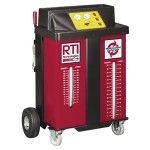Radiator flush versus coolant flush
Should you get a radiator flush or coolant flush
Every Spring and Fall shops advertise specials on a radiator flush service. You may think a radiator flush is the same thing as coolant flush. It’s not. A radiator flush is exactly what the term implies; the shop drains the radiator and refills it with coolant. But the radiator only holds a small portion of the coolant in your engine.
Here’s what’s involved in a real coolant flush
To do a complete coolant flush, the technician connects cooling system flush machine
to your engine and fills it with fresh coolant. The machine pumps the new coolant through the engine and heater core to push the old coolant out where it can be recycled. A coolant flush service hookup and operation is more labor intensive and expensive than a radiator flush.
Ask more questions before you get a coolant flush
Most late model vehicles come from the factory with a long life coolant that’s formulated specifically for the metal, rubber and plastic components in your engine. Unfortunately, many shops don’t use the factory recommended coolant when performing a radiator flush or coolant flush. Instead they use “universal All-Makes-All-Models” coolant. That way they don’t have to stock the many different coolants required by all the brands.
There’s one big problem with that approach; not a single carmaker recommends using any type of universal coolant. Contrary to the conspiracy theorists, it’s not because they want to cash in on coolant sales. Many companies make aftermarket coolant that meet the carmakers specifications. Prestone, for example sells universal coolant. But they also make 8 manufacturer specific coolants. So any shop can get the right coolant without have to run to the dealer.
If you’re getting a radiator flush or coolant, make sure the quote includes using the recommended coolant. Using the wrong coolant can reduce resistance to corrosion. Read this post on the damage caused by the wrong coolant.
Why carmakers use different coolants
All engine coolants use a polyethylene glycol or polypropylene glycol base. That makes up about 85% of the coolant. Older coolants used silicate or phsphates additives to prevent corrosion. Silicates coat internal metal parts to prevent galvanic action that can eat away at the radiator, heater core, water pump seals and bearings, and metal heater tubes.
However, the newer long life coolants still use a polyethylene glycol or polypropylene glycol base, but use organic acid (OAT) or hybrid organic acid technology (HOAT) anti-corrosion addiitves. Both these chemistries have additives that must be compatible with the seals used in the engine. Switch to a different coolant and you can damage the seals.
So skip the radiator flush specials. They’re worthless. If your cooling system is due for service, take your vehicle to a shop that will flush with the factory recommended coolant.
©, 2015 Rick Muscoplat
Posted on by Rick Muscoplat
